The 2013 MacBook Air Review (13-inch)
by Anand Lal Shimpi on June 24, 2013 12:01 AM ESTCPU Performance
To measure CPU performance we begin with a fairly standard measure of system responsiveness: boot time. With the last generation of upgrades to 6Gbps SATA, we saw a good decrease in boot time over the previous generation platforms. The new 13-inch MBA's PCIe SSD takes the crown as it boots ever so slightly quicker than last year's setup. In practice the difference is subtle, but something you can appreciate as the 2013 MBA's IO is just snappier all over.
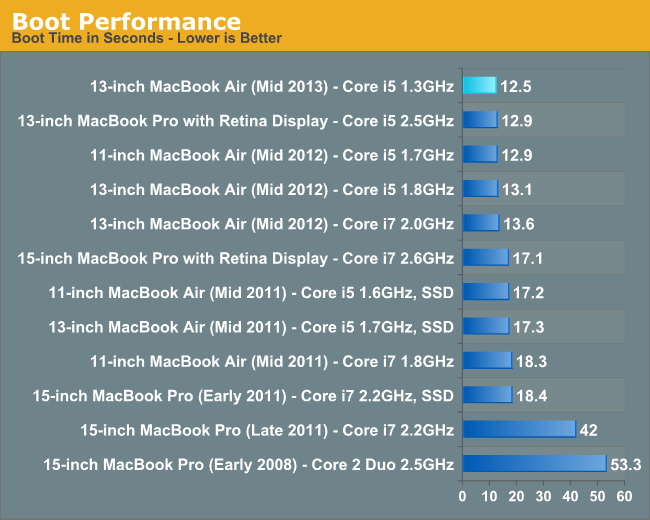
These next two charts look at single and multithreaded floating point performance using Cinebench 11.5. This test also gives us the rare opportunity of comparing to some older Mac Pro hardware as well from 2008 - 2010. Single threaded performance remains extremely important to overall system responsiveness, so it's always good to look at. As we found in our initial look at the new MBA, the 1.3GHz Core i5 CPU ends up performing about the same as last year's 1.8GHz part. I'd like to say it's all because of cooling and turbo boost, but in all likelihood Apple is trading some of Haswell's IPC gains for frequency here - enabling identical performance, at lower clocks thanks to Haswell's more efficient architecture.
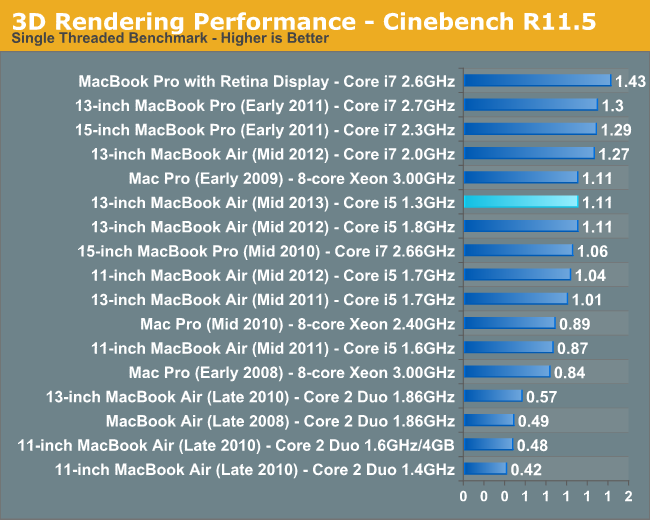
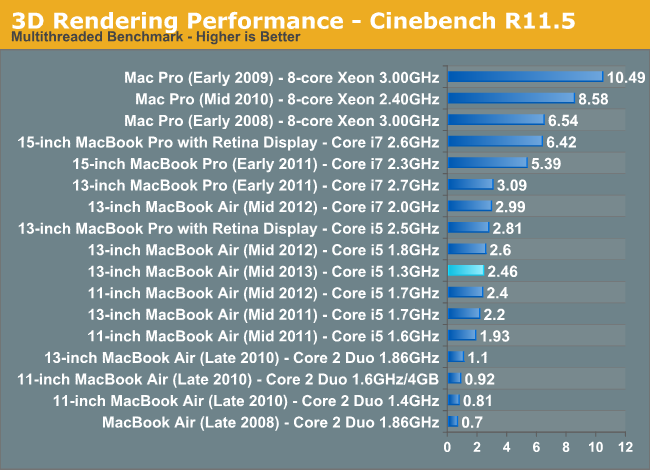
The multithreaded performance story is a bit different. The 1.3GHz i5 regresses in performance by about 5%. Overall performance is still quicker than the 2011 models, as well as the i7 based 11-inch MBA from 2012. Here we're simply seeing the 15W TDP limits come into play. Sharing both PCH and dual-core CPU power in a lower thermal footprint than last year's CPU alone is responsible for what we see above.
Video transcoding is really best suited for the higher end machines, but that doesn't change the fact that it's done on MacBook Airs as well. We'll start by looking at performance under iMovie. Here we're importing 1080p video from a Nikon D7000 and optimizing it during import.
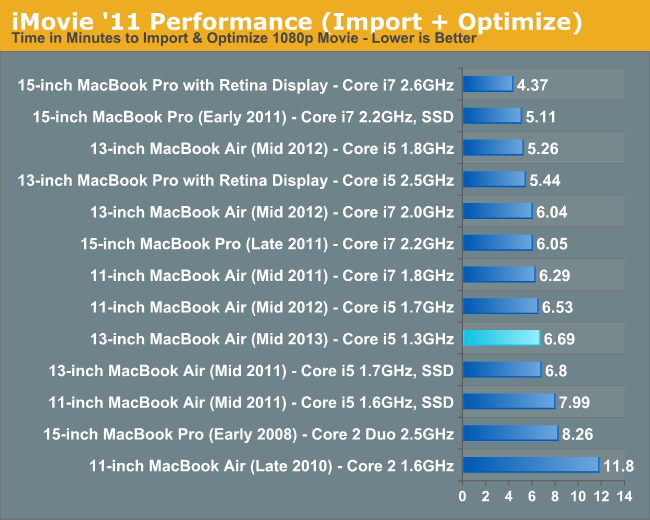
The 13-inch 1.3GHz Core i5 configuration performs similarly to last year's 11-inch 1.7GHz config. It's an interesting comparison because the 11-inch 2012 model is more thermally constrained than the 13-inch 2012 model, which is exactly what we see when we compare the 2013 13-inch MBA to the 2012 13-inch MBA. In this case the 2013 model is a hair quicker than the 2011.

We see a similar story for a full video export. The 1.3GHz 2013 MBA slots in behind the 2011 model in this CPU bound test.
Final Cut Pro X falls on the professional end of the video production spectrum. The test file is the same here, but the workload is far more strenuous.
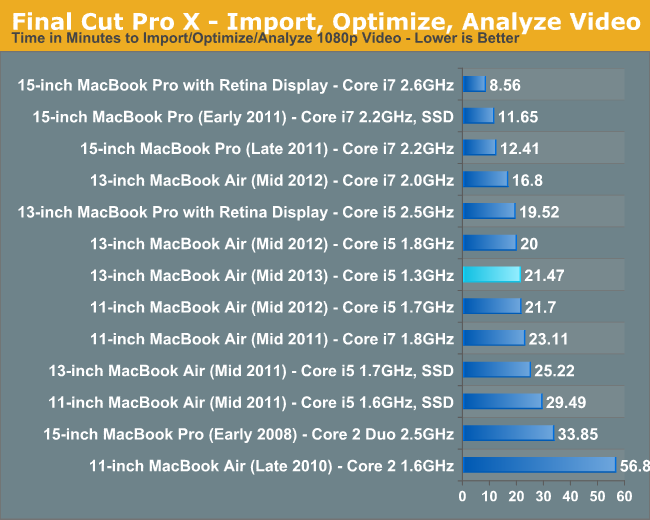
Once again, we see roughly the same performance from the 13-inch 2013 1.3GHz i5 as the 11-inch 2012 MBA. Here we do see substantially better performance than the 2011 models.
Our two photo workloads generally agree with what we saw in the video tests. The 1.3GHz Haswell part is definitely slower than th e previous generation 1.7/1.8GHz SKUs:
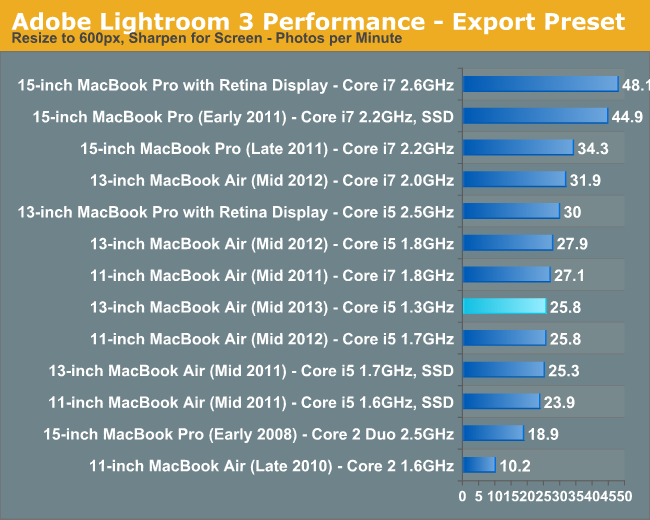
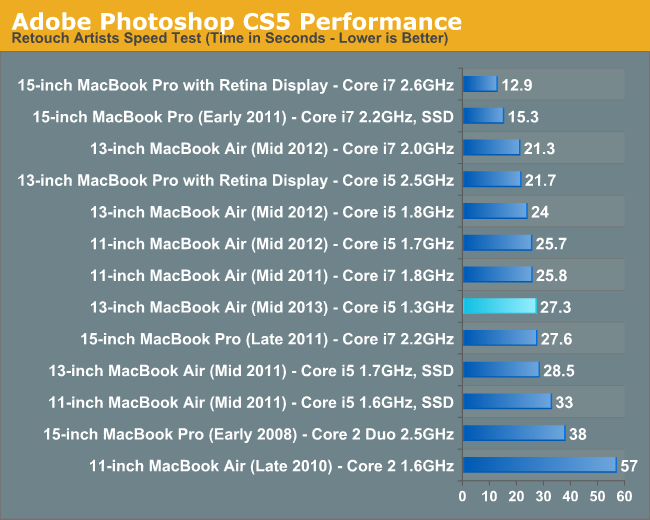
In our desktop review of Haswell I noted that performance in our compile test improved tremendously with the new architecture. As it's quite obvious that Haswell's IPC advantages don't surface all that much in our traditional suite, I wanted to see if perhaps things would be different in something that might lend itself better to Haswell's IPC improvements. I repeated our Firefox build test but under OS X. It's a multithreaded compile, with the number of threads set to 2x the number of cores (not threads) in a system. Unfortunately I came up with this bright idea while traveling, so I only had access to three machines: the 2013 13-inch MBA, the 15-inch rMBP and a 2GHz Core i7 2012 13-inch MBA. I'll add more results later, but I'm expecting this to be a part of our test suite going forward.

The combination of Haswell and a really fast SSD appears to help narrow the gap between the much higher clocked 2012 model and the base 2013 13-inch MBA. Here the faster Ivy Bridge CPU is less than 2% quicker. I'll reserve final judgements until I get my hands on the 1.7GHz Core i7 model, but my guess is this is an example of the best case scenario for Haswell where you get equivalent performance to a higher clocked Ivy Bridge part but with much better thermal/noise/battery life characteristics. For example, the fan was never audible on the 2013 MBA while running this test compared to running at a very noticeable volume on the 2012 Core i7 model. The same goes for temperatures. The i7 2012 model tends to run about 5% warmer along the bottom of the chassis compared to the 2013 i5.










233 Comments
View All Comments
seapeople - Tuesday, June 25, 2013 - link
Brightness is pretty much the number one power consumer in a laptop like this (which is actually mentioned in the review). If you expect to run anything at 100% brightness and get anywhere near ideal battery life then you are bound to be disappointed.name99 - Monday, June 24, 2013 - link
"802.11ac ... better spatial efficiency within those channels (256QAM vs. 64QAM in 802.11n). Today, that means a doubling of channel bandwidth and a 4x increase in data encoded on a carrier"This is a deeply flawed statement in two ways.
(a) The modulation form describes (essentially) how many bits can be packed into a single up/down segment of a sinusoid wave form, ie how many bits/Hz. It is constrained by the amount of noise in the channel (ie the signal to noise ratio) which smeers different amplitudes together so that you can't tell them apart.
It can be improved somewhat over 802.11n performance by using a better error correcting code (which essentially distributes the random noise level over a number of bits, so that a single large amount of noise rather than destroying that bit information gets spread into a smaller amount of noise over multiple bits).
802.11ac uses LDPC, a better error correcting code, which allows it to use more aggressive modulation.
Point is, in all this the improved modulation has nothing to do with spatial encoding and spatial efficiency.
(b) The QAM64 and QAM256 refer to the number of possible states encoded per bit, not in any way to the number of bits encoded. So QAM64 encodes 6 bits per Hz, QAM256 encodes 8 bits per Hz. the improvement is 8/6=1.33 which is nice, but is not "a 4x increase in data encoded on a carrier".
We are close to the end of the line with fancy modulation. From now on out, pretty much all the heavy lifting comes from
(1) wider spectrum (see the 80 and 160MHz of 802.11ac) and
(2) smaller, more densely distributed base stations.
We could move from 3 up to 4 spatial streams (perhaps using polarization to help out) but that's tough to push further without much larger antennas (and a rapidly growing computational budget).
There is one BIG space for a one-time 2x improvement, namely tossing the 802.11 distributed MAC, which wastes half the time waiting randomly for one party or another to talk, and switching to a centrally controlled MAC (like the telcos) along with a very narrow RACH (random access channel) for lightweight tasks like paging and joining.
My guess/hope is that the successor to 802.11ac will consist primarily of the two issues I've described above (and so will look a lot more like new SW than new DSP algorithms), namely a central arbiter for a network along with the idea that, from the start, the network will consist of multiple small low-power cells working together, about one per room, rather than a single base station trying to reach out to 100 yards or more.
bittwiddler - Monday, June 24, 2013 - link
• The keyboard key size and spacing is the same on the 11 and 13" MBAs.• The 11" MBA is exempt from being removed from luggage during TSA screenings, unlike the 13.
• The 11" screen is lower height than most and doesn't get caught by the clip for the airplane seat tray table.
• When it comes to business travel computing, I'm not interested in a race to the bottom.
Sabresiberian - Monday, June 24, 2013 - link
One thing I would NOT like is for Apple to make a move to a 16:9 screen. I'd certainly rather have 1440x900 on a 13" screen than anything denser that was 16:9. I mean, I'm one of the guys that has been harping on pixel density and refresh rates since before we had modern smart phones (the move to LCDs set us back a decade or more in that regard), but on a screen smaller than 27", 16:9 is just bad. In my not-so-humble opinion.4:3 is better for something smaller than 17", but I can live with 16:10. :)
Kevin G - Monday, June 24, 2013 - link
Re-reading trough the review I have a question about the display: does it use panel self refresh? I recall Intel hyping up this technology several years ago and the Haswell slides in this review indicate support for it. The question is, does Apple take advantage of it?Kevin G - Monday, June 24, 2013 - link
I think that I can answer my own question. I couldn't find the data sheet for the review panel LSN133BT01A02 but references on the web point towards an early 2012 release for it. Thus it looks like it appeared on the market before panel self refresh was slated for wide spread introduction alongside Haswell.hobagman - Monday, June 24, 2013 - link
Hi Anand & all -- could I ask a more CPU related question I've been wondering about a lot -- how come the die shots always look so colorful and diverse, when isn't the top layer all just interconnects? Or are the die shots actually taken before they do the interconnects, consisting in the top 10-15 layers? Would really appreciate an explanation of this ...hobagman - Monday, June 24, 2013 - link
I mean, what are we actually seeing when we look at the die shot? Are those all different transistor regions, and if so, we must be looking at the bottom layers. Or is it that the interconnects in the different regions look different ... or ... ?SkylerSaleh - Tuesday, June 25, 2013 - link
When making the ASIC, thin layers of glass are grown on the silicon, etched, and filled with metal to build the interconnects. This leaves small sharp geometric shapes in the glass, which reacts with the light similarly to how a prism would, causing the wafer to appear colorful.cbrownx88 - Monday, June 24, 2013 - link
Please please please revisit with the i7 config - been wanting to make a purchase but have been waiting for this review (and now waiting on the update lol).